Triennials Out of Time: ruangrupa and documenta fifteen
James McAnally and farid rakun
February 2023
Triennials Out of Time is a series of short conversations featuring artistic directors and curators of cyclical exhibitions. Organized by James McAnally for the Counterpublic 2023 civic exhibition and published by MARCH: a journal of art & strategy, the series will unfold gradually throughout the next several months.
Across disparate forms, Triennials Out of Time considers whether the slow build and release of multi-year, cyclical exhibitions may offer a more humane pace that allows proper engagement, inquiry, and reorientation to one’s place and publics. A wide range of participants ask: Can triennials and other cyclical exhibitions carry the seeds of other art worlds less reliant on spectacle and extraction that these circuits have long perpetuated?
In this first conversation, Counterpublic 2023 Artistic and Executive Director James McAnally speaks with farid rakun of ruangrupa, Artistic Directors of documenta fifteen.
ruangrupa is a Jakarta-based collective established in 2000. It is a non-profit organization that strives to support the idea of art within urban and cultural context by involving artists and other disciplines (such as social sciences, politics, technology, media, etc.) to give critical observation and views toward Indonesian urban contemporary issues. ruangrupa also produces collaborative works in the form of art projects such as exhibitions, festivals, art labs, workshops, research, as well as book, magazine, and online journal publications. As an artists’ collective, ruangrupa has been involved in many collaborative and exchange projects, including participating in the Gwangju Biennale (2002 & 2018), Istanbul Biennial (2005), Asia Pacific Triennial of Contemporary Art (Brisbane, 2012), Singapore Biennale (2011), São Paulo Art Biennial (2014), Aichi Triennale (Nagoya, 2016), and Cosmopolis at Centre Pompidou (Paris, 2017). In 2016, ruangrupa curated transACTION: Sonsbeek 2016 in Arnhem, NL and were Artistic Directors for documenta fifteen (Kassel, 2022).
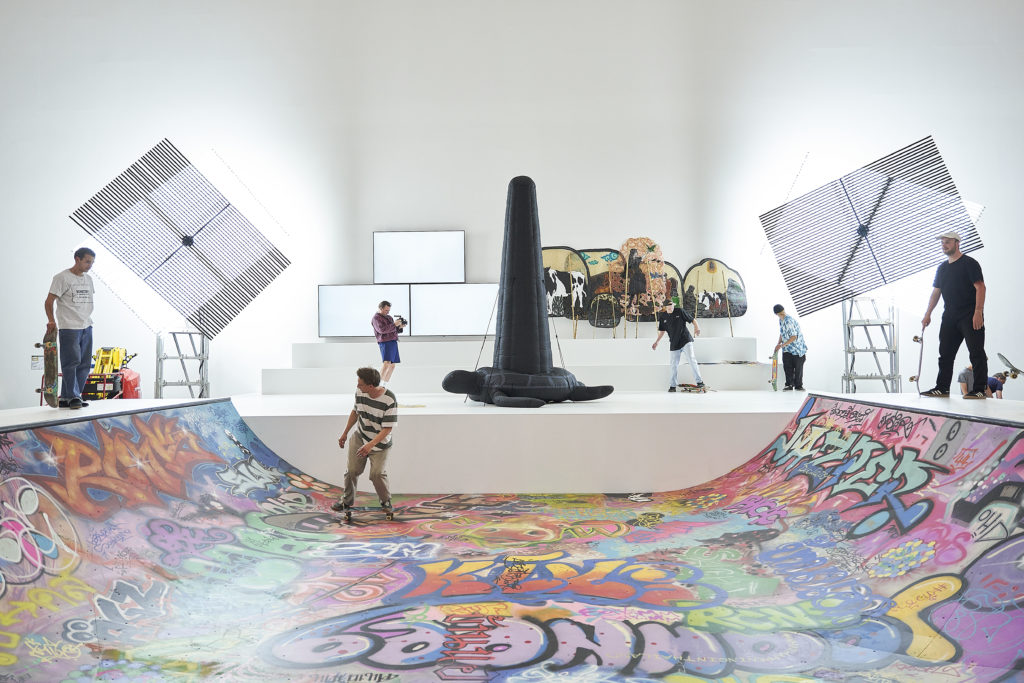
Baan Noorg Collaborative Arts and Culture. The Ritual Of Things, 2022. Installation view at documenta fifteen, Kassel, DE. Photo: Nicolas Wefers
James McAnally: We are both coming to this conversation holding multiple roles. For me, as both the founder of Counterpublic and artistic director of its 2023 edition, as well as a co-founder and editor of this journal. Given those different positions, I feel like I have a different relationship to agency, or to imagining what is structurally possible within our approach to exhibition-making. Setting those different methodologies into practice from the outset, as opposed to fighting against them or inheriting other ways of working, offers a different foothold than most curators in the bi- and triennial contexts.
For you, and for ruangrupa, you’ve also engaged in these kinds of cyclical exhibitions in many different roles. As artists, you’ve participated in many over the years, from the São Paulo Art Biennial to Gwangju Biennale. In an organizational mode, you were interim director for the Jakarta Biennale. So prior to and separate from documenta fifteen entirely, you’ve engaged these forms in numerous ways over time. I’m curious, across those experiences, what draws you back to this particular way of exhibition-making or engaging space, city, community, and ideas within your own work? What has that made possible for you?
farid rakun: I think pre-documenta, ruangrupa went through a time of learning. We were founded in 2000 because of our shared interest in urban spaces. At that moment, the artistic ecosystem in Jakarta was ripe for young artists like ourselves to be rethought, added to, or complemented because what was already there was not sufficient or was not aligned with our interests. I didn’t come from an art background (I studied architecture) and ruangrupa was trying to touch upon things not only from painting and sculpture per se, but also street art, music, video, much more immersive installation, even research-based approaches. That approach wasn’t so strong at that moment – again, it’s different right now – but there was a notion of artistic research and we wondered how we could use it for our interests. So we made a lot of events. Those events were an entry point for many of us, including myself, because they drew from different disciplines. At that moment, there was a need coming from students. I was a student back then in 2004 as well and wanted to meet other students. That type of platform wasn’t available, so ruangrupa made one. For example, the formal schools in Jakarta didn’t have curatorial programs, so we made crash courses for curating because of our need to write and curate. We learned by doing. It was a new species in the ecosystem.
The Jakarta Biennale is another case. It was a biennial that was founded in the 1970s by the Jakarta Arts Council and was discontinued around 1998 but resuscitated around 2009. ruangrupa was part of it because we are part of the Jakarta artistic ecosystem. Slowly, we took on bigger roles in it – mostly as individuals, not as ruangrupa as a whole. We wanted to learn whether it was possible to make such institutions different and how to institute ourselves. We wanted to understand what that meant and what kind of access we could gain. We are involved in events like biennials because they hold a certain gravity.
Then, starting in 2009, the Jakarta Biennale (as well as the Biennale Jogja) started to invite foreign artists to the city, so its scope also became international. All those waves basically culminated. Today, of course, we make a lot of attempts to question the exhibition format itself; but still, the format holds because of the history, because of how previous editions are talked about, and this creates discussions that sustain it further than a single edition.
In the process, we learned what part we could play in the ecosystem and how we wanted to push it with our own agenda, our interest in how art can play a role in not only cultural but also political or social spheres – not separate from life, but part of life itself. I mean, art is not more important than life, but it has an agency that negotiates with other parts of life; for example, economically. We wondered how we could propose a reality that’s different from what has been the driving force for many artists, especially young artists in school – all those things they have been told to think about being successful or being able to live from the art they make.
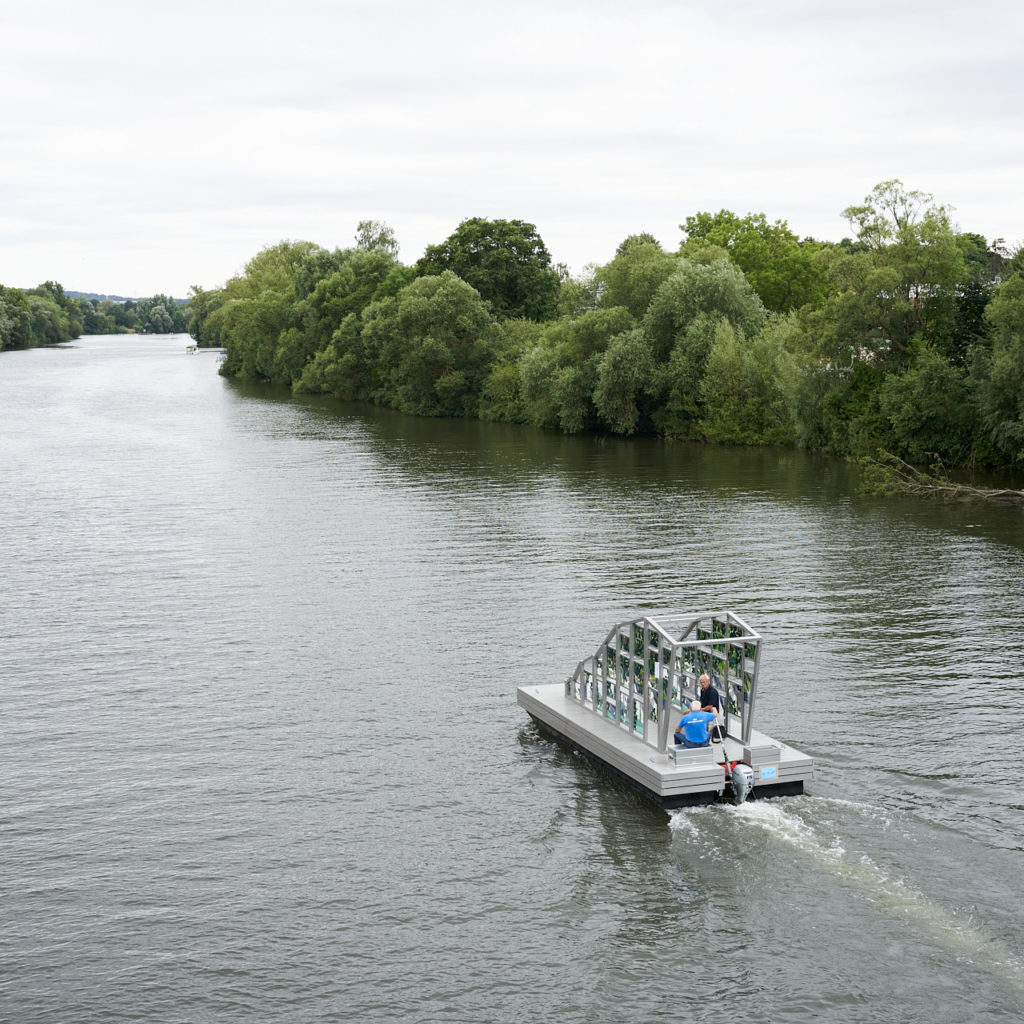
Chang En-Man. Floating System for Snails, 2022. Floating on the Fulda River during documenta fifteen, Kassel, DE, July 2022. Photo: Nicolas Wefers
JM: I appreciate what you’re pointing to in this idea of the gravity of the biennial being a tool itself. I think any institution’s form of organizing is an instrument in some way, meant to be put to use. Most of these structures present themselves with the logic of the exhibition, or of the experience in which you enter this container that has already been established. I’m curious to hear your thoughts on what kinds of tools a biennial, whether Jakarta or documenta, wields now. It has this understood history as a form that has been very good at cultural export from an imperialist viewpoint. It’s certainly good at spectacle, at galvanizing attention, perhaps at experimenting with new contexts for artistic research or presentation. It’s good at all these things, but, in your view, what is the tool that it still offers for artists and curators, for a different art world?
fr: When we started documenta fifteen with that journey of ours called lumbung, the answer to why we should keep going changed almost every year. By the end of 2018, we came to an important moment when we started thinking of ourselves as a resource to sustain others – as well as ourselves – with space and money, of course, but also time. That allowed us to start thinking about the potentialities in an honest way, I would say.
To answer the question: documenta, of course, holds a lot of resources. Different people see it in different ways. Maybe it’s about the spotlight. Maybe it’s about the production budget. Sometimes it’s about the discourse itself; sometimes it’s the street cred. So that’s the question we tried to open up through lumbung. From the outset, we asked the people we worked with how they could use this opportunity to be part of documenta to sustain their practice. Different answers came up, but it’s still documenta – meaning what you said: the exhibition-making logic is still prevailing. We had to negotiate with its logic, let’s say. It is an institution that has excelled for sixty-plus years. At least some people would argue that it is one of the best examples of how an exhibition-making institution could be a model. We can agree with it, we can disagree with it, but it is true that they think about themselves that way and a lot of people outside think about them that way as well. Within that context, we forced ourselves to think about documenta as a bank of resources. We also asked them to think about themselves that way. It was not easy. On paper, conceptually, of course, it’s nice and sunny, but then, when it comes to the practice of this idea . . . I think we knew that it was going to be a challenge.
I think one of the most important lessons for us is that this practice relies on an almost daily basis of struggle and negotiation. In other words, ruangrupa is running with a particular operating system while others are running with different operating systems. So, what can be done? I don’t think it’s going to happen that often – these different operating systems being forced to clash – even after documenta fifteen, but we think it’s very valuable to do it.
Right now, of course, this is not a full reflection. We are in the process of digestion. I’m talking for us, for ruangrupa itself: What can be done with these resources we have access to? That is kind of the next thing. How to do it first, and then what can be done to enrich others as well? Then the next step is whether we can do it or not. I think we used documenta fifteen with a similar impulse to why we founded OK. Video, an international media arts festival. We use the exhibition, the event, the festival to be able to invite people to intensively talk and learn from others. Lumbung has been happening for a while, but with documenta fifteen, we wanted to push it to another trajectory and give it legs to walk further.
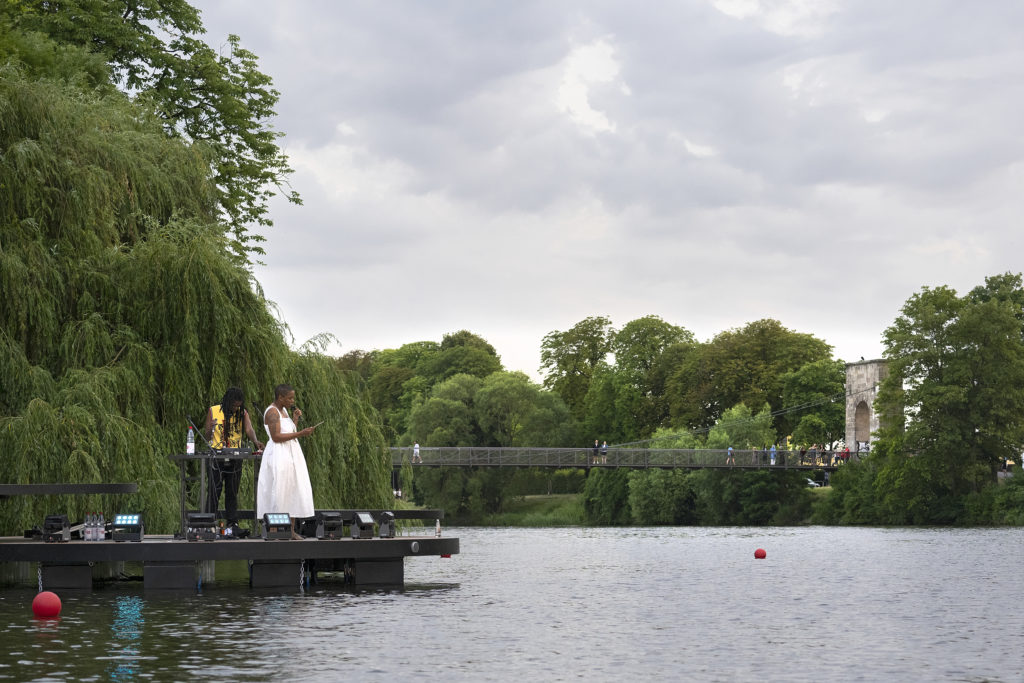
Black Quantum Futurism with Irreversible Entanglements. Watch Night Service, 2022. documenta fifteen, Rondell, Kassel, DE, June 19, 2022. Photo: Nils Klinger
JM: In terms of the lumbung approach, I heard a lot about how it produced a kind of “collective of collectives.” I feel like the writing and conversations about your communal storehouse idea inherent in lumbung focused on the multiplication of participants and collaboratives spreading horizontally. That is, of course, a major part of how you organized the exhibition. In relation to Counterpublic 2023, I was particularly interested in the idea of the storehouse in terms of what lasts, what remains after the exhibition. The lumbung, or collective storehouse, offers an opportunity toward duration. I’m curious if you’ve started thinking about that or reflecting on what the longer view of documenta fifteen for you and its participants may be, or if that was part of the process of your thinking? What is that storehouse giving out over time?
fr: That’s the biggest challenge right now actually, to make sure that it stores something, with the intention of making it last longer. That’s what we’ve been discussing over the last few months. And afterward, for others, because if we cannot sustain ourselves, then it doesn’t make sense, unfortunately. We know we shouldn’t be the center of lumbung after documenta fifteen. This practice shouldn’t just be dependent on ruangrupa, and it isn’t, which I’m happy to see. Lumbung film screenings, for example, are happening in different places by different lumbung artists, independent from us. So that kind of stuff is actually happening.
Having benefited from some artistic networks, we realize that we should not just replicate those networks, such as Arts Collaboratory, for example, or Triangle Network. Because we are not coming from that world, we are not the best people to organize such a network. So we ask: How can it be different? To be artistic is one answer to it. Relationships are another. Some relationships might last and some relations might not. That’s natural; we shouldn’t force it. But if we think about documenta fifteen as lumbung one, then other editions of lumbung should happen again. If you ask me right now, learning from lumbung one, the scale should not be that big. I might have a different answer if you ask me in the future, but scale is one issue: documenta fifteen was too big for something grassroots like lumbung. Also, the time frame should be longer. For example, lumbung interlokal [the international network of the fourteen lumbung members of documenta fifteen] didn’t have enough time because of the exhibition-making logic. It should have more non-productive time. I’m not sure that’s a good word for it – but not trying to make an exhibition, not trying to make work. Maybe a year of only affinity-building so people can get to know one another. And then this was, of course, during the pandemic as well. So our intention to make people meet or assist each other didn’t happen, but even if it could have happened, it would have been for too short of a time.
So scale, time, as well as space or geography. Staying in the local as much as possible. Maybe in the region. The understanding of an ecosystem can go beyond our specific geography. For example, it might be natural for us to work with someone in Mexico or Colombia. So, just as an example, we can hold an event in Indonesia collaborating with others from different parts of the world, not necessarily only in Southeast Asia. But it doesn’t have to be the whole network, and the network doesn’t always have to agree. Small things. Small, but often. I think that logic became more apparent for us. The idea that “small, but many” could be an approach that could work.
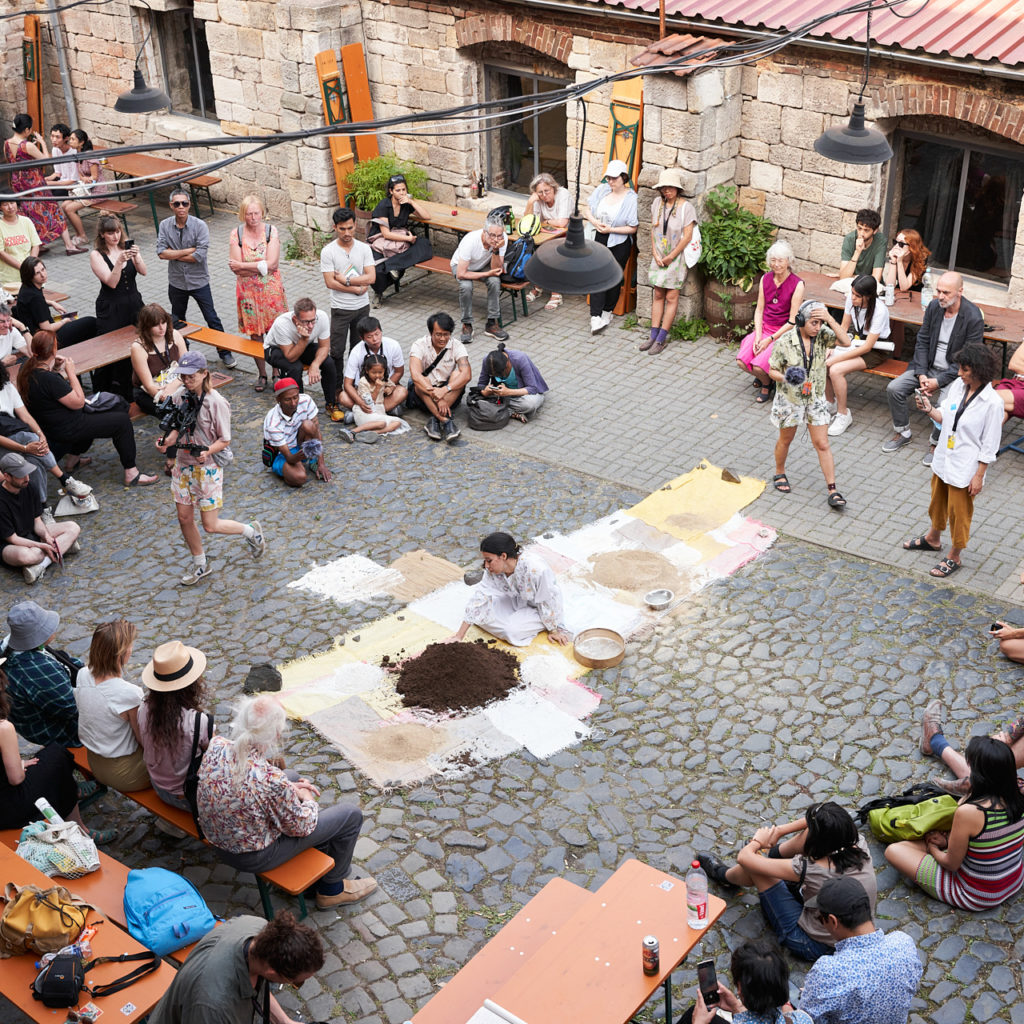
Imane Zoubi with LE 18. Is Our Bread Ready Yet? (Act I) at documenta fifteen, WH22, Kassel, DE, June 19, 2022. Photo: Nicolas Wefers
This approach might not have what we discussed before: the culmination of space and event, with people from all over coming to one place and sharing one experience together. It might not have that aspect due to its small scale, but it creates many approaches. It’s much more sustainable, for one. It’s much more doable, second. And then also, it doesn’t have the burden of everything needing to be presentable. And it’s much more honest, let’s say.
Whether we want our work to hold so much power at this global scale again after this . . . I think if you ask me, my answer is no. But then, ruangrupa is not only me. So it has different answers, and that question has different answers. The thing that still holds us together, though, is asking: How can we use this opportunity while we still have this position of being able to do things? Because that also relates to time. Next year, we might not be in the same position.
JM: What’s clear in that, too, is that these things typically coalesce as an exhibition is made. I think that lumbung, clearly, was not just an exhibition that was on view. It’s a methodology that continues to evolve. It gets tried out and tested. It’s clear that where it lives on is not going back to this moment of documenta as lumbung, as a moment where it coalesced, but as an ongoing process. It is a method. You learned things and you would adapt it differently, as you said. And it needs to be taken up and tried in different ways. Implicit to the entire experience of documenta fifteen were the ways in which what you were producing was less an exhibition than a working out of a methodology or protocol in some way.
fr: It is a method and an exhibition. We are not anti-exhibition. We think that exhibition can play a part among other methods. We tried to reflect that with the structure of documenta fifteen itself. To a certain extent, we were successful. In other ways, we failed. Our intention was to make non-departments, because usually the exhibition is the top beam and then every other department is a pillar. Education, publication, all of those things. We tried not to think about it that way. But in reality, again, in practice, we still fell into certain traps in which it can be understood or read that the exhibition is still the summit of everything.
JM: I think that was there and came through. Certainly, it was an exhibition, particularly in moments, but I do think that the other ways, these non-departments, sat alongside it in ways that it did not feel like the other things happening were somehow under the exhibition. It felt like there was life happening, and also there was an exhibition happening. And the exhibition made some of those forms of life possible. I do think that it worked to both be an exhibition in which there were beautiful moments of encounter with an object – or a practice or a space that was very much in that format – but it didn’t seem to eclipse the other energies happening.
fr: Thank you for that. How people feel they’re being treated becomes more clear when you’re inside the system. Then the learning or the challenges become more transparent. Between the curatorial department, the production department, the public program department, the publication, those discussions happened a lot. But even without us, outside of us, I believe there’s so much richness that we can learn from and that could be revisited. But it’s still too early. I think everyone is reeling from the experience – everyone working with us.
JM: I wanted to maybe pick up one loop that you were talking about before. This feeling you mentioned that there wasn’t enough time to gather in ways that were non-productive, a building together that is not toward something. That it’s building affinity, it’s building shared knowledge, but not building an exhibition with a public output. Within this series of conversations, and within my own work, this is something that I’m thinking about a lot. In talking to people who operate biennials, almost all of them feel like the pace is impossible. And then, for me, we’re organizing a triennial, and that has its own pace and it feels somewhat more spacious. We try to think about our temporariness as an asset. It’s a luxury in a lot of ways within the art world to have something like a three-year cycle. For us, it offered time. For a year, we just talked to our neighbors. We didn’t approach artists; we didn’t dictate the program. There wasn’t a plan in place until after we had a year of just being in our city and talking to people and understanding what the ground was saying to do, what was it time for. But still, after that initial breathing room, we find ourselves trapped. Suddenly we have to produce something of this scale and in this complexity and it feels like time is scarce again. So I think intentional time of reflection, of gathering or affinity-building, is a possibility of this triennial form, but it’s hard to get outside of that logic of rapid production. It is so easy to lose sight of some of those core “slownesses” that I think it offers, counter to many of the other parts of art worlds that we operate in.
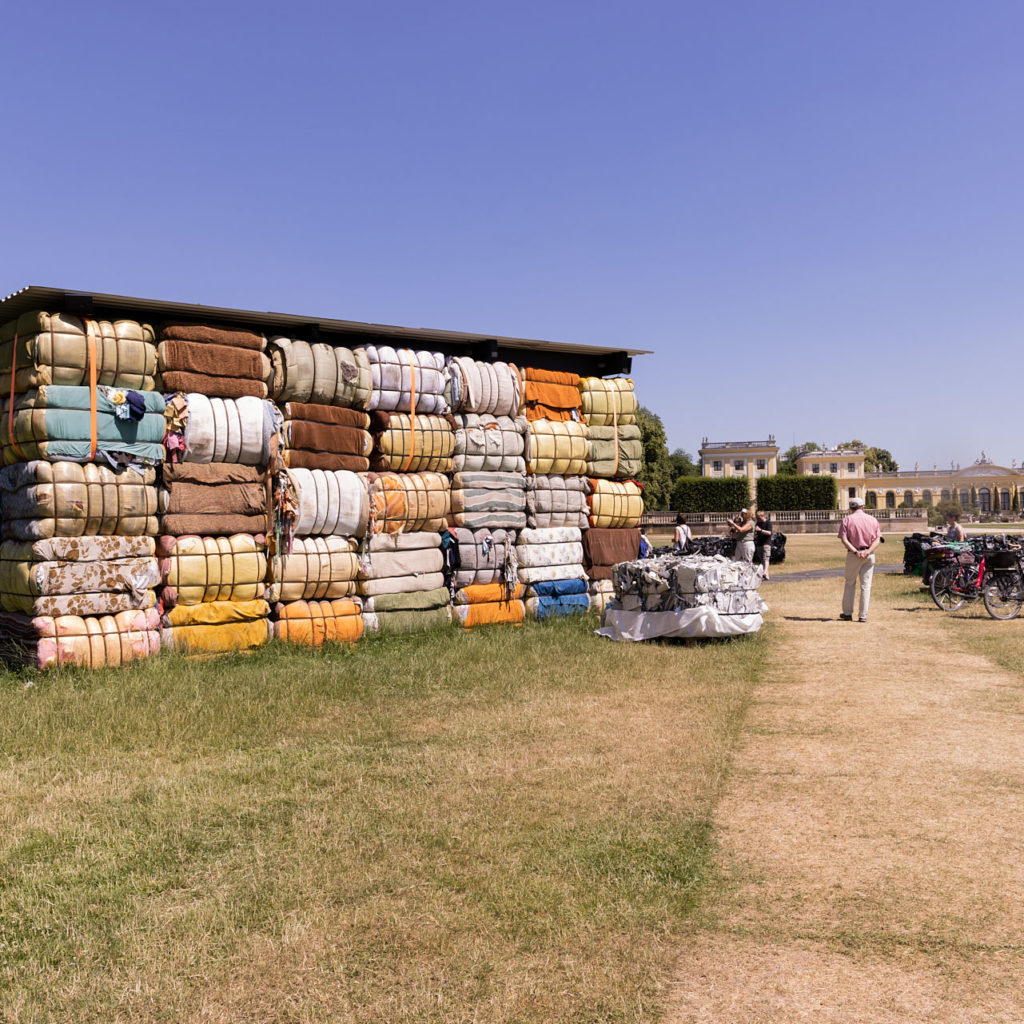
The Nest Collective. Return to Sender, 2022. documenta fifteen, Karlswiese (Karlsaue), Kassel, DE. Photo: Victoria Tamaschko
fr: I think conceptually, at least, many biennials that I know are trying to tackle that problem as well – making it longer, let’s say. Of course, it’s still happening every two years, but then five editions were being thought of as one package. It doesn’t always have to include the same people, but that way, certain ways of thinking might persist.
Things that we learn from documenta – of course, as they accelerate again right now – is that they reinvent themselves every five years. That’s not sustainable if you ask me. That’s crazy for the institution as well. There’s a brain drain of the organization straight after one edition is done. The institutional memory isn’t passed on. Of course, some people stay. Ten percent maybe, or less, and those are the only people who have the institutional memory. But still, they pride themselves on that – keep on changing, changing, changing, changing, and following the artistic director at that moment.
Then the next question is: What is documenta in between iterations for the public? We were late, comparably. But we worked for three years and we were late. Of course, to those of us who work on it, it’s different. But then, as an institution, one that is for neighbors, as you said, what function does it hold? Because at least, through Covid times, one of the lessons we learned – I don’t know whether you agree or not – was that neighbors are actually a very important part of our practice. They sustain us as well in the middle of challenges like Covid. I don’t know how institutions – not only biennials but museums as well, or schools – that think about themselves from the get-go as global, as international (and of course alienate themselves from their neighbors as a consequence) survive through that. For us, then, it becomes a question. Biennale Jogja, for example, at least on paper, just finished a cycle of five editions that have one thread. They are always changing their editions, but then there’s a thread. Because of that, certain things will help keep the memory. Whether it’s the right thread to hold them together or not, that’s another discussion. But the strategy they came up with was actually something I learned from a lot. As it is rotating, even without an edition of a biennial, certain things are still being built, and all those things are being talked about through a conference or publication or education or something that’s not an exhibition but can still produce meaningful work. Take the São Paulo Art Biennial, for example. Their education department is almost independent from the editions themselves. It’s strong as well. It left a strong impression, learning from them.
JM: One that comes to mind that I track with is the Toronto Biennial of Art. It has only had two cycles so far, but it had the same lead curator, Candice Hopkins, and continuity within the curatorial team for both editions. Before they did one, they determined that the same team would be organizing two exhibitions, which was one way that I appreciated that out the gate they were thinking about, “Okay, how do we resist this pace?”
For us, at core, the way that we’ve positioned Counterpublic is intentionally to use a triennial to create a sort of engine of generational change. For me, creating a throughline and building that into the triennial from the outset was a way to focus our efforts, to focus my thinking, and to focus resources toward specific ends. Running an organization or series of programs, it is really hard to get that perspective, to say we’re trying to do one thing but be transformational with how we do it. That was the decision for me, at least, organizing within the place that I have lived and worked for a long time, where I ran an independent space that this bloomed out of, and where I have tried lots of different models in the art world, from writing and publishing to that kind of large-scale network organizing.
Ultimately, I felt this is a format that I can believe in, even if I don’t really experience it that way most of the time. With bi- or triennials, I feel this simmering possibility. But for myself, reflecting on that, what is it to step back and gather oneself toward a moment in which there can be a pivot or gathering of resources or energies in the ways that we’ve talked about?
fr: I think there are two layers, at least that you were talking about. One is internal or the ecosystem – for example, the neighbors and all that stuff. A lot of it is invisible. And it’s fine. For us, at least, it’s fine to keep it invisible. Some stuff is just impossible to translate to an exhibition, let’s say. And then the second thing is when to make it public, and to provide an experience that actually addresses that and feels like that. Those two layers provide different challenges as well. If we can do both layers and make them support each other, not only in parallel but in a way that feels the same way and shares the same DNA, I think we hit the sweet spot.
James McAnally is the Executive + Artistic Director of Counterpublic 2023. He additionally serves as an editor and co-founder of MARCH: a journal of art & strategy, was the co-founder and director of The Luminary, an expansive platform for art, thought, and action based in St. Louis, MO, and a founding member of Common Field, a national network of independent art spaces and organizers. McAnally has presented exhibitions, texts and lectures at venues such as the Walker Art Center, Kadist Art Foundation, Pulitzer Arts Foundation, The Artist’s Institute and Gwangju Biennale. McAnally’s writing has appeared in publications such as Art in America, Art Journal, Bomb Magazine, Hyperallergic, Terremoto, and he is a recipient of the Creative Capital / Andy Warhol Foundation Arts Writers Grant for Short-Form Writing.
Trained as an architect (B.Arch from Universitas Indonesia and M.Arch from Cranbrook Academy of Art), farid rakun wears different hats depending on who is asking. He is a part of the artists’ collective ruangrupa with whom he co-curated transACTION: Sonsbeek 2016 in Arnhem, NL and provided a collective Artistic Direction for documenta fifteen (Kassel, 2022).